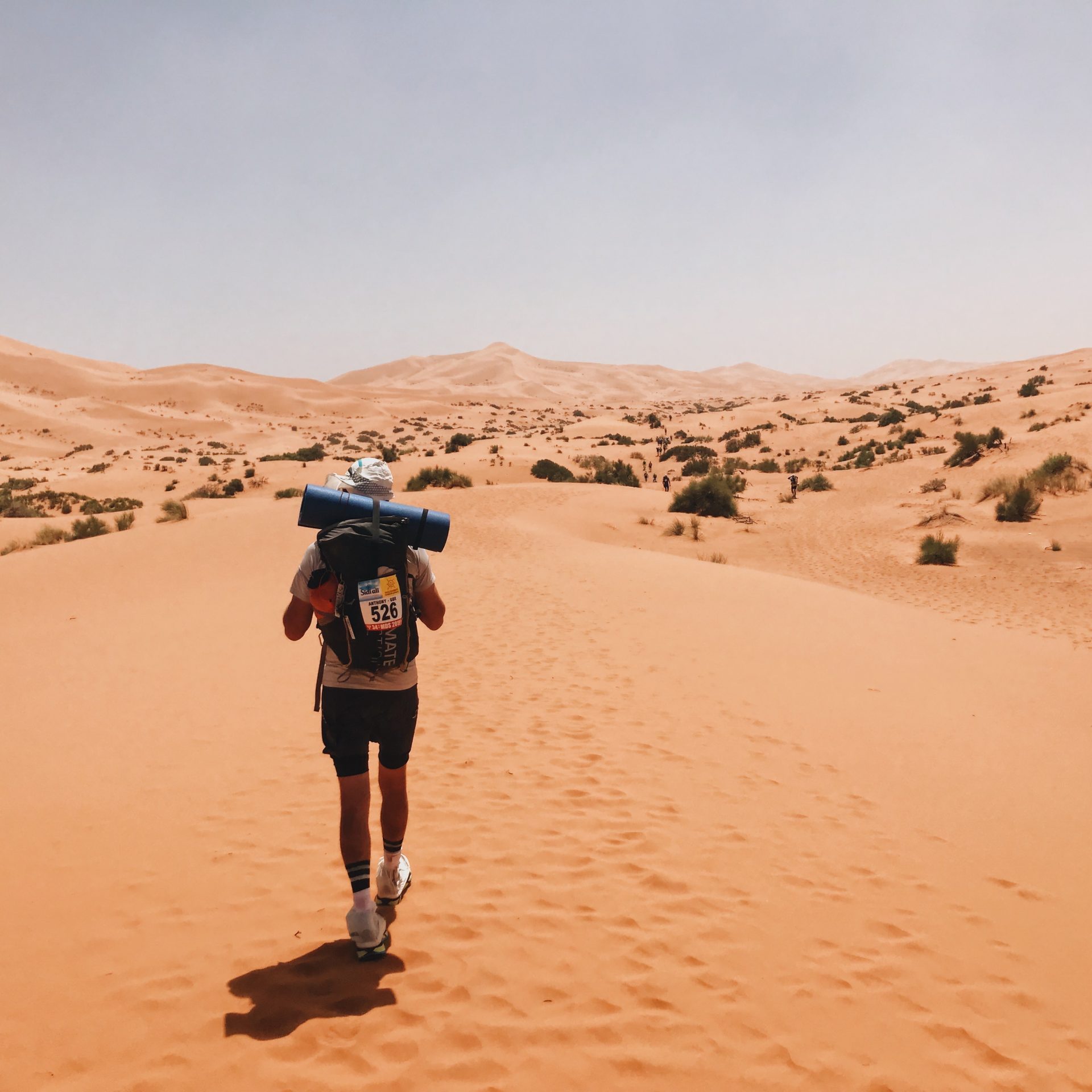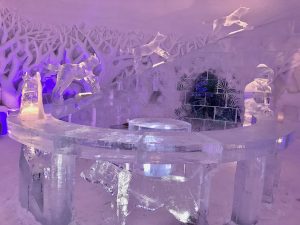Looking for things to do in Kirkenes, but can barely make it out on that tiny little dot on your dusty old atlas?
I feel you. Been there, done that, got the “I stayed in an Ice Hotel in Norway” t-shirt.
That humble brag, however, is merely one highlight of many potential options that you can experience in this action-packed city in the Arctic Circle.
It’s also a fascinating city in terms of history, the 3 countries that have contended its ownership and as you’ll find out by the end of this post, there are oh-so-many quirky/adventure things to do in Kirkenes…
History of Kirkenes
The lands surrounding what is now Kirkenes spent much of its history as a quiet and desolate place. High in the Arctic Circle and hostile lands of northern Europe, the territory was treated as a common Norwegian–Russian district. That’s until 1826 when the official border was finally drawn in the snow and the village fell on the Norwegian side.
The original name of the peninsula that surrounds the modern town was known as Piselvnes, meaning Pis River headland. When the Kirkenes Church was built in 1862, the village and area were renamed Kirkenes, meaning ‘church headland’.
Back then, Kirkenes was a very remote and sparsely populated area, with only a few families calling it home throughout the 19th century. In 1906, iron ore was discovered nearby which led to the establishment of the mining company A/S Sydvaranger.
Within a few years, the population had swelled to 8,000. Thousands came from all over Europe, and by the early 20th century, Norwegian, Sámi, Finnish, Russian, Swedish, English and German were widely spoken, creating a real melting pot of North European cultures.
With the outbreak of the Winter War between Finland and the USSR in 1939, the subsequent occupation of Norway by Nazi forces and the following years of the Second World War, Kirkenese became the focus of heavy fighting.
In July 1940, Kirkenes was occupied by German forces, and up to 100,000 troops were based here, using it as a jumping-off point for the invasion of the USSR. As a result, Kirkenes holds the morbid distinction of being one of the most bombed places in Europe during the Second World War, with at least 320 devastating Soviet raids smashing the town.
Almost completely destroyed during the war, including the church that gave the town its name, Kirkenes was rebuilt as part of the post-war Marshall Plan funded by the USA – this resulted in Kirkenes being the first town in northern Norway to get sealed roads paved in.
The iron market fell in the 1990s, and the Sydvaranger mining company was shut down in 1996, which led to hard economic and social times in the town. Kirkenes then began a revival with the arrival of petroleum-drilling activity in the Barents Sea and a rise in tourism in the town.
Where is Kirkenes?
Kirkenes sits at the extreme northeast of Norway, well within the Arctic Circle. The town of Kirkenes is also only eight miles from the Russian border and thirty-two miles from the border with Finland.
Sitting so close to these contesting national powers meant that throughout its history, the town and peninsular were contested areas. However, in 1826, the border was finally drawn along the map, and Kirkenes is now an uncontested town that belongs to Norway.
To make matters even more confusing, Kirkenes resides in the municipality of Sør-Varanger, which is in the county of Finnmark (which is the largest county in Norway and even bigger than neighbouring Denmark!)
Best Time To Visit Kirkenes
You probably won’t be too surprised to learn that Kirkenes is pretty cold all year round, with long winters and short summers. When it comes to rainfall, it’s generally nonexistent, making Kirkenes one of the driest places in all of Norway.
Part of the Arctic Circle, Kirkenes sees daylight for 24 hours from the 17th of May to the 21st of July and faces a dark period, with the sun permanently below the horizon, from the 21st of November to the 21st of January. And it’s these daylight hours, rather than the weather, that you’re going to want to take into account when you’re planning a trip here.
Possibly the best time to visit Kirkenes is during the later winter months; late January/early February. Visiting Kirkenes during this time allows you to experience the winter wonderland that is northeast Norway in all its white-washed beauty while still having some kind of normal solar clock.
How Long Should I Stay in Kirkenes?
Visiting the town of Kirkenes may not be the jam-packed itinerary you may expect from the typical tourist trail in Europe, and yet it is somewhere that deserves time and dedication. I stayed for three nights in Kirkenes and found it to be just about the right length of time.
While it’s more than possible to spend a night or two here, the effort and time it takes to travel to Kirkenes and the number of activities and sights to see in the area mean that one night really isn’t enough.
With three days to play with, you can travel, settle in and truly experience everything an ice hotel in Norway and the northeast section of the Finnmark region has to offer.
How To Get To Kirkenes
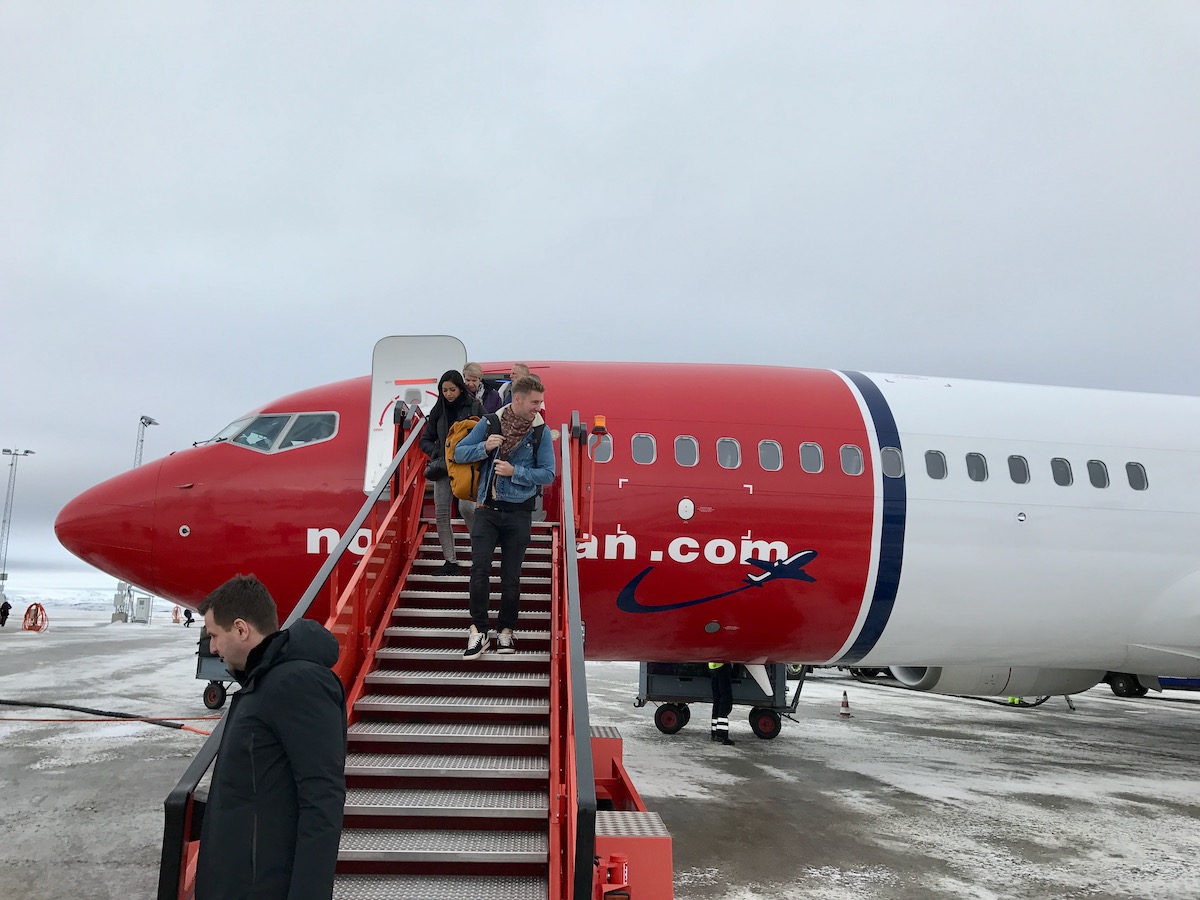
Kirkenes is extremely isolated, and getting there isn’t an easy feat from most places in the world. There are, however, several ways to do it, depending on where you’re coming from.
From Abroad
Found at such a huge distance away from the rest of the world, most people who want to visit the ice hotel in Norway, and the town of Kirkenes, choose to fly into the area.
The closest airport to the town is the Høybuktmoen airport (KKN), which is eight miles west of Kirkenes. Norwegian Airlines and Lufthansa are some of the only airlines to head this way.
Daily domestic flights head into Høybuktmoen airport from a number of Norwegian towns and cities, including Oslo, Tromsø and many more. Depending on your departure city, you may need to catch a connecting flight in one of these cities before heading up north to Kirkenes.
For a better idea of flight times, paths and prices, here’s a quick overview of some of the most popular travel hubs:
- London ~ 9 hours, 1 connection in Oslo, <£200
- Sydney ~ 53 hours, 3 connections, < AUD$2,000
- Amsterdam ~ 15 hours, 1 connection in Oslo, <€250
- Chicago~ 15 hours, 2 connections in Copenhagen and Oslo, <US$D900
- Munich ~ 9 hours, 1 connection in Oslo, <€350
- Atlanta ~ 20 hours, 3 connections, <USD$1,600
- Singapore ~ 42 hours, 2 connections in Frankfurt and Oslo, <SG$D2,200
Sometimes, you can catch a direct flight to Høybuktmoen airport from Russia and Germany, though these only tend to run during Kirkenes’ summer months, which coincides with the busier season.
It can even be cheaper to fly to the Finish town of Ivalo and make the journey by bus north. Just like the direct flights, these bus routes only run regularly during summer, and more sporadically during the winter months.
Most of the flights that land at Høybuktmoen airport will have a bus waiting to take you the eight miles to the town of Kirkenes, costing about 85 NOK. However, you can also take a taxi from the airport, which will set you back around 300 NOK for a maximum of four people.
From Western Norway by sea
One of the more elaborate ways of getting to Kirkenes is to arrive via boat. For over a century, the Coastal Express ship has sailed the waters around Norway, taking passengers from Bergen and Trondheim in the west to Kirkenes in the east.
Arguably the most beautiful sea voyage on the planet, the journey covers most of the Norwegian coast in five to six days. This is less of a quick and efficient way of getting to the ice hotel in Norway, yet it is one that adds another element of adventure to your trip. Prices start from around 6,000 NOK and up.
From Russia via rail
2024 edit: With the recent war between Russia and Ukraine and all of the sanctions placed upon Russia; I can not say with the same confidence that this option is still possible.
Although Kirkenes has a railroad, it isn’t used as a passenger train but rather a commercial one for transporting ore and other industrial goods. This being said it is possible to take a train from St Petersburg, Moscow or even the Russian and Chinese cities in the far east to the Russian border town of Nikel, only thirty-four miles away from Kirkenes.
This network of railways connects Nikel to the vast expanses of the Russian stops and throughout Asia, thanks to the Trans-Siberian Railway. Again, this isn’t the most efficient way of getting to Kirkenes, but it is an option for those in Russia or anyone that wants to add a little more adventure to the journey.
For a rough idea of train prices to Nikel:
- From St Petersburg ~ 450 NOK
- From Moscow ~ 650 NOK
Getting Around Kirkenes
You’re out in the cold wilderness when you’re travelling around Kirkenes. Say bye-bye to your Ubers, fancy trains and coaches. When getting around Kirkenes your options are usually snowshoes, husky sledges or the most badass of all… snowmobiles!
Other than that it’s car rental or busses, but bear in mind that once you’re in the Ice Hotel, you will be more than likely using the non-conventional transport modes mentioned above.
Bus
There are pretty much three bus routes that cover most of Kirkenes and nearby towns:
- Bus number 111 connects Kirkenes, Hesseng, Sandnes and Bjørnevatn.
- Bus 112 connects Kirkenes, Elvenes, Jakobsens and, on some routes, Tårnet.
- 110 is a local city bus that journeys around the town centre.
Car Rental
It’s also possible to drive yourself around while visiting Kirkenes, provided you have a license; no international driving licence needs to be sorted before you go.
The main car rental service in Kirkenes is Sixt Bilutleie, which operates at two locations; in the town itself and from Høybuktmoen airport. This means you can rent your car as soon as you touch down and even drive it back to the airport before you fly out if you wish.
Sixt, Hertz and Europcar all operate in the area, and from the airport, though you will find local companies that may work out cheaper too. A week’s rental with comprehensive insurance starts from around 2,500 NOK and steeply rises depending on the model of the car you’re after.
20 Cool Things To Do in Kirkenes (+ 2 Day Trips!)
Nestled within the Arctic Circle and surrounded by some of the most breathtaking scenery in all of northern Europe, Kirkenes is a place that will never cease to provide you with lots of cool things to do, mainly of the adventure travel variety.
So let’s take a look at 20 of the things to do in Kirkenes, catering for travellers of all tastes…
1. Ride a Snowmobile and Explore!
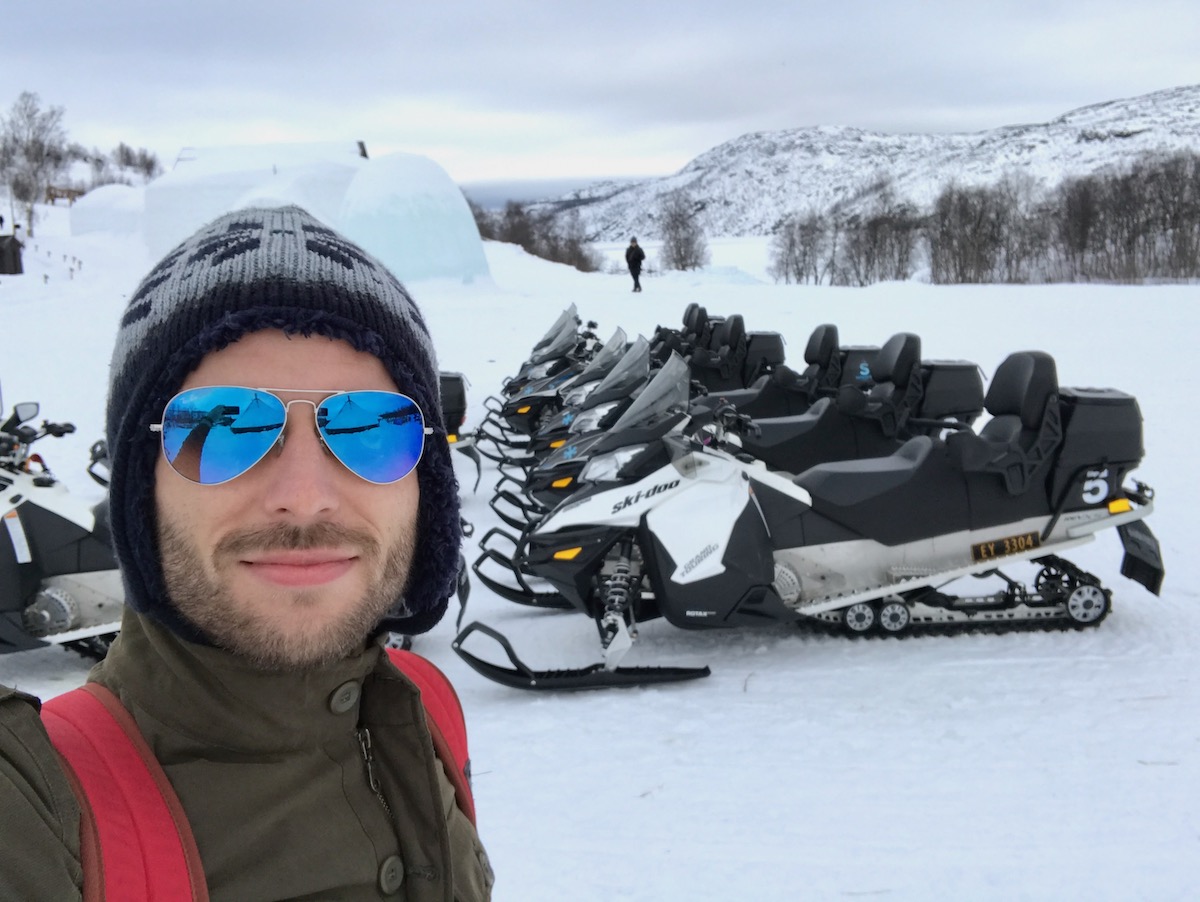
When you think of the intrepid snow-white lands of Scandinavia, the adventurers among us can’t help but imagine jetting through virgin snow at speed, upon a snowmobile, James Bond style.
Joining a snowmobile tour of the area surrounding Kirkenes is one of the most magical ways to really take in the landscape while also providing that undeniable adrenaline rush.
An overnight snowmobile tour is arguably the best way to do this activity. You will jet off through the nearby fjord and through the woods towards the popular Pasvik Valley.
Feeling the arctic wind cut through as you speed across the snow is like nothing else. With the sun going down and the atmosphere of an Arctic Circle night surrounding you, the experience is one you will not forget in a hurry.
Know before you go:
- Location – Tours usually begin and end at the Snow Hotel, but you’ll explore the surrounding area during the tour.
- Cost – Around 2,000/2,500NOK, though the price is sometimes lower if you include it as a package with your stay at your hotel.
- Opening hours – Tours usually begin in the evening.
- Time needed – Tours last for a couple of hours or longer, depending on the package you choose.
- Getting there – This tour begins and ends at your accommodation, so no need to worry about transport!
2. See The Midnight Sun
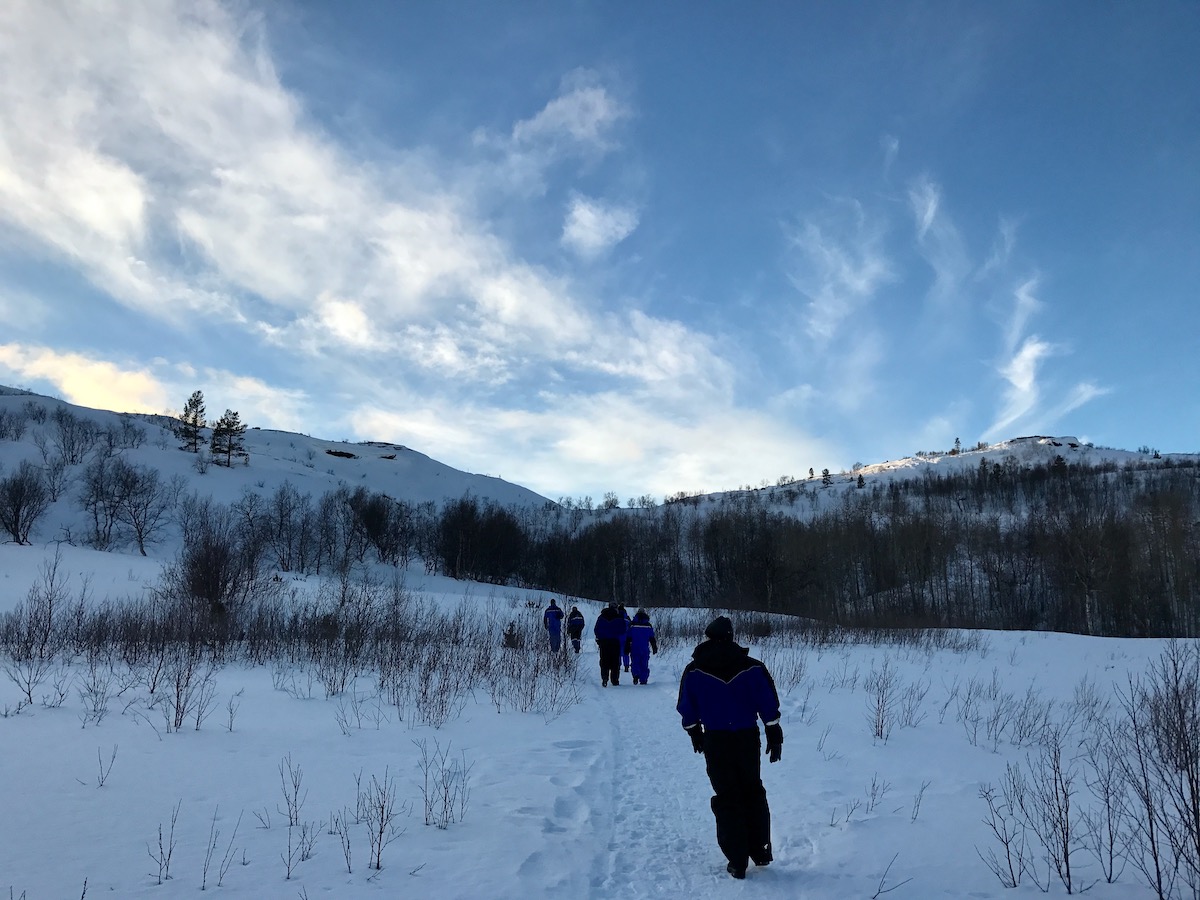
During the summer months in Kirkenes and the Arctic Circle as a whole, there is often no distinction between 12 am and 12 pm. Much like parts of Patagonia, the sun rises and sets like clockwork for the rest of the globe, being so far north, the sun may stay in the sky throughout the midnight and early hours.
Looking at the sun in the sky while the watch on your wrist says 00:00 is a surreal experience, yet one that is awesome to experience even once in your life. Although it is possible to see the midnight sun anywhere in this part of the world, Høyde 96, just south of Kirkenes, is a truly magnificent spot to gaze at during the midnight hour.
A watchtower overlooks the deep conifer forests and the calm rivers and lakes on both sides of the Norwegian-Russian border, only adding to the beauty of the scene and the epicness of your photographs.
Know before you go:
- Location – As long as you are there during early summer, you will see the midnight sun from anywhere in this part of the world.
- Cost – Depends on snowmobile rental from your hotel, (it could be part of your safari package if you ask).
- Opening hours – Surprise surprise: 00:00/12 am!
- Time needed – It’s fun to set aside a good half hour to take in the sights and significance of what you’re looking at.
- Getting there – You’ll need to join a tour to head out this way or go on an adventure on your own four wheels.
3. Watch The Northern Lights Aurora Borealis
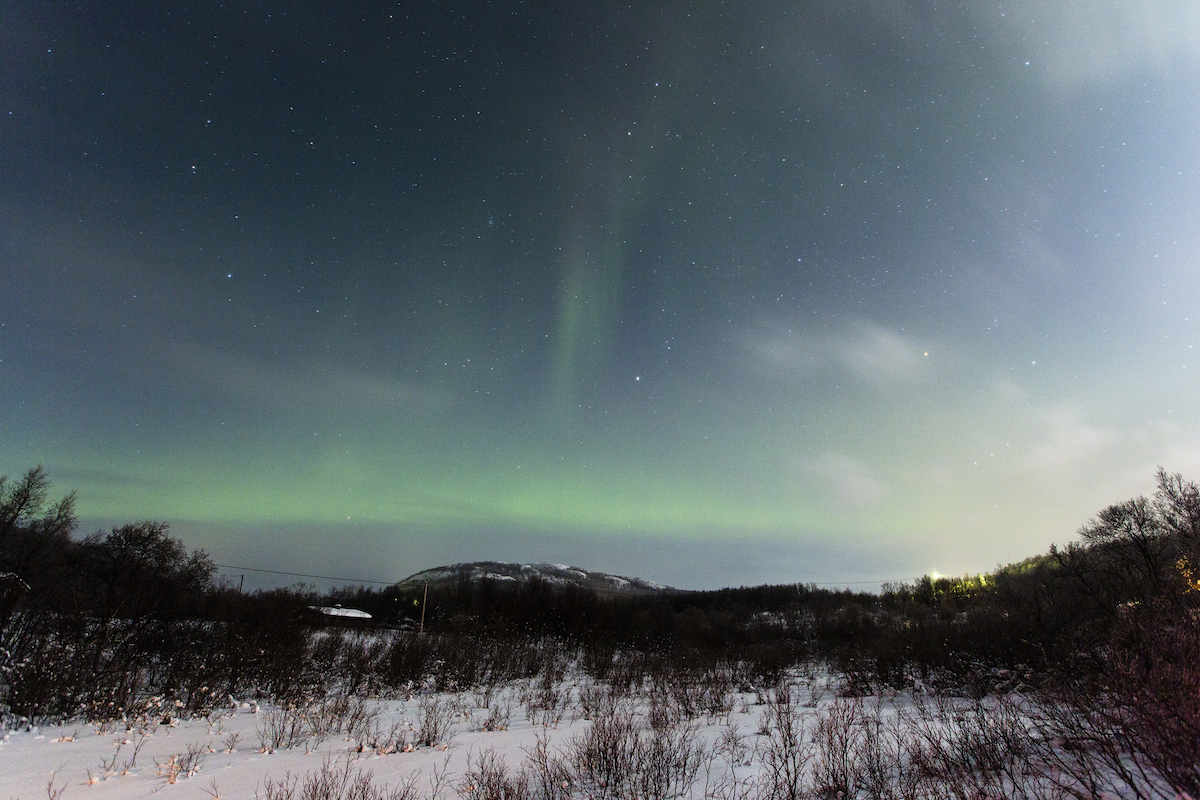
Arguably one of the top reasons for visiting this part of the world is to get a chance to have a proper look at the Aurora Borealis, more commonly known as the Northern Lights. As well as being far enough north to experience this phenomenon, the dry and clear winter climate of Kirkenes and the surrounding area increases the chances of experiencing these dancing lights.
Pretty much every hotel runs Northern Lights hunting tours, taking you out on snowmobiles, husky-led sledges or the more comfortable AuroraExpress bus. To get the best chance of seeing the Northern Lights, you will need to join this tour between the start of September and mid-March.
Sometimes the lights are clear and easy to see, while other times you may have to do a little hunting. The hotel can help you to arrange this tour, complete with transportation and a local guide who is experienced in finding the best views of the magical Aurora Borealis.
Know before you go:
- Location – The tour will start and end from your hotel, yet seeking the lights may take you deep into the surrounding wilderness.
- Cost – By bus NOK 1,000, by husky NOK 2,500, by snowmobile NOK 2,700 per person.
- Opening hours – Tours depart around 9 pm each night.
- Time needed – Set aside at least two or three hours.
- Getting there – As above!
4. Pet a Reindeer
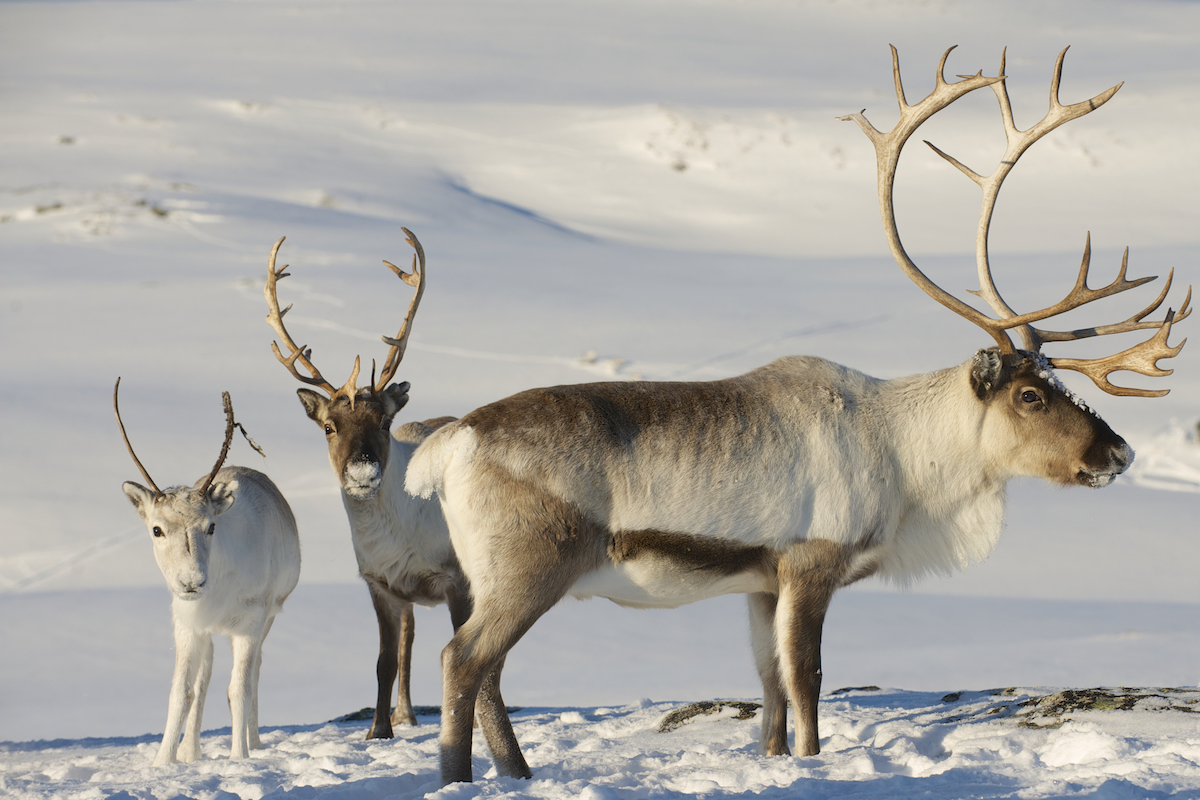
While zipping through the snow and seeing the famous Northern Lights are all well and good, no childhood dream of the Arctic Circle would be complete without petting one of Santa’s faithful steeds, a reindeer.
One of the most fantastic places to catch sight of your very own Prancer, Rudolph and Dasher is at the Gabba Reindeer Safari Park, just adjoining the Snow Hotel.
Here you can see a huge herd of reindeer, including some of the rarer white reindeer. There’s nothing quite like reaching over and petting these gentle giants. As friendly and approachable as the reindeer are, it is important to remember that they aren’t pets and will require you to show them the same respect and caution as you would any other wild animal.
Know before you go:
- Location – The reindeer are located close to the ice hotel in Norway.
- Cost – Free.
- Opening hours – It’s best to come and see the reindeer around midday when they are at their most active.
- Time needed – An hour should be enough to watch the animals in their herd and interact with them.
- Getting there – A small walk away from The Snow Hotel.
5. Munch on Native berries
It might sound a little boring at first but to those with a sweet tooth, the local berries are like candy-coated crack.
Kirkenes is home to a number of different restaurants and eateries, serving up a wide range of food that is native to the surrounding area. One of the most prominent and famous of these is the wide range of native berries. The surrounding Arctic bogs are the perfect habitat for the forging of these berries, but you won’t have to go to such extremes to try them for yourself.
Some of the must-try wild berries include the bilberry, a small and much darker berry than the more common blueberry.
Another is the cloudberry, an orange-coloured berry that is extremely high in vitamin C, making it one of the most expensive berries when bought anywhere else in the world. The most famous berry grown in this part of the world has to be the lingonberry – anyone who has visited the well-known global furniture store IKEA will probably recognise these as a side in some of their meals.
Whether you try them in their natural form or secure yourself a jar of jam or berry preserve, sampling these wild berries is definitely a welcome addition to your taste buds.
Know before you go:
- Location – To eat some of the native berries, head to one of the local restaurants, including your on-site at your hotel.
- Cost – Costs will all depend on where you buy the berries and in what form.
- Opening hours – Shops and restaurants will open and close at various times, so find opening times beforehand to avoid disappointment.
- Time needed – Sampling the native berries can be done from the comfort of the hotel, so that’s up to you.
- Getting there – A short walk or a taxi to one of the restaurants in Kirkenes town.
6. Grenseland Museum
The Grenseland Museum is located just south of the town and is a fantastic place to learn about the long history of, not only the town but of the wider border regions of Norway, Finland and Russia.
The museum has a range of permanent exhibitions, each one with a different theme, including the area’s industrial construction, war history and the daily life of the frontier people through the ages.
Aside from the permanent exhibits, the Grenseland Museum also plays host to a number of ever-changing exhibitions. This being the case, it’s great to check ahead of your visit to see what’s on at the museum during your time visiting the ice hotel in Norway.
The stunning foyer of the building is also often used as a location for cultural events, another reason to research and see what the Grenseland Museum is presenting during your time here.
Know before you go:
- Location – The museum is found at the southern end of Kirkenes, just to the east of Førstevatn Lake.
- Cost – The entry fee is 40 NOK.
- Opening hours – Winter: 10:00 am to 2:00 pm. Summer: 10:00 am to 6:00 pm.
- Time needed – Give yourself a couple of hours to explore the museum.
- Getting there – It is easy enough to walk a short distance from the centre of town to the museum.
7. Dog Sledding
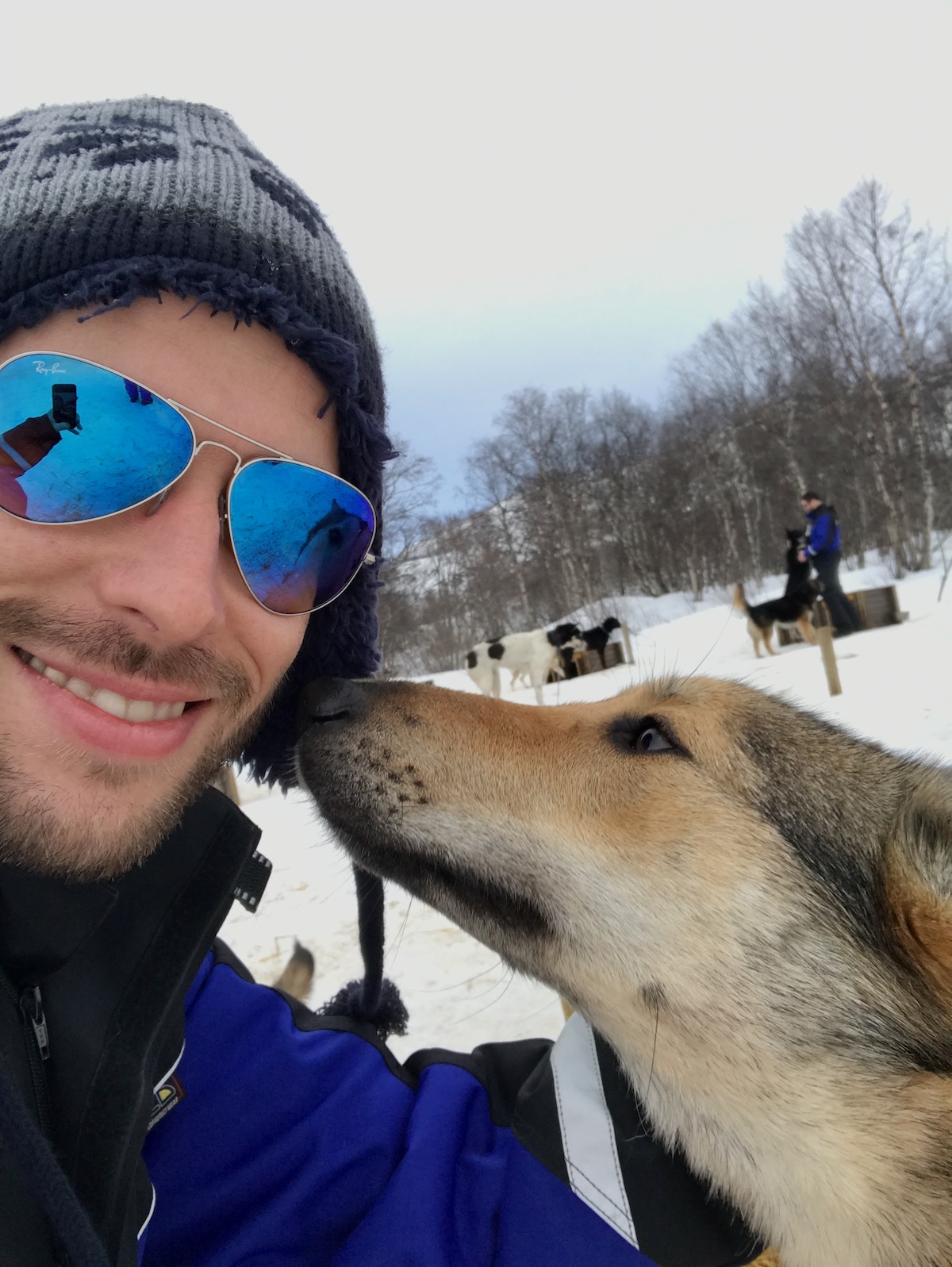
One of the most popular ways to experience dog sledding in perfect surroundings is to join a sledding tour with a local family business such as Birk Husky.
Located within your own cabin near the Norwegian – Russian border, the tour has you in one of the most jaw-dropping environments, complete with snow-covered landscapes, zero light pollution and another chance to spot those acclaimed northern lights.
Once you’re ready to go, you and your dogs will whizz through the ice fields, perfectly lit with the low light of a 9 pm sunset and the stunning landscapes all around you. Once you have spent around an hour and a half sledding through the Arctic Circle, you will then head back to your cabins for an evening of locally cooked food in a wooden tee-pee, perfectly centred around a fire pit and good conversation.
You can hang out with the dogs before, during and after, they are a dog lover’s dream; full of love and affection and the goodest of boys and girls!
Almost everything that involves animal tourism is often sketchy and this one admittedly had me torn. The dogs seemed “well looked after,” but years later I pretty much don’t ride on, or with any type of animals anymore because it’s much easier to abstain to be if you have concerns over potential cruelty or suffering.
That’s my personal choice and you have to make these calls yourself, I just thought it was worth an extra mention for those who are concerned and this particularly sad article might be an eye-opener for dog lovers with good intentions.
Know before you go:
- Location – Dog sledding with Birk Husky is located south of Kirkenes, close to the Russian border.
- Cost – The whole tour will cost around NOK 3,000.
- Opening hours – The tour will usually take place around evening time, 8/9 pm.
- Time needed – The actual sledding lasts for 90 minutes, but the experience is bulked out with preparations and a post-sledding meal.
- Getting there – As part of the tour, transport to and from the site will be provided.
8. Visit Chinatown
Nine out of fifty people in the world are Chinese; a staggering fact about the world population and one that makes you understand why you can find Chinatowns in pretty much every city around the world.
And still, it may come as a surprise that the Arctic Circle town of Kirkenes has its very own Chinatown. Where this Chinatown differs is the fact it is not born out of Chinese immigration to the area but was constructed as part of the Barents Spektakel Festival.
This festival is designed to ‘bridge borders’ and does so by staging public discussions, seminars and visual art exhibitions.
One of the installations took the form of Chinese signs throughout the streets and a major Chinese-inspired constructed gate along the walking street, adding layers to the experience of visiting the Arctic Circle. Festival dates vary throughout the year but usually take place during February.
Know before you go:
- Location – During the festival, Chinatown can be found on the town’s walking street.
- Cost – Free
- Opening hours – 24 hours.
- Time needed – An hour or so will be plenty to explore the Chinese displays of Kirkenes.
- Getting there – Being in the centre of town, it is easy enough to walk to Norwegian Chinatown.
9. Eat at The Ritz
Though the title may conjure up images of London’s famous five-star hotel, the Ritz restaurant in Kirkenes may not be the haunt of the rich and famous, but its food is famous enough. The small and cosy restaurant in the heart of Kirkenes town is a fantastic place to warm yourself up with a tasty meal.
Specialising in pizzas, Ritz offers a wide range of meals both local and Western, including a selection of vegetarian and vegan dishes. Set across the road from Walking Street, the Ritz is the perfect place to sit and watch the world go by while enjoying a well-deserved dinner after a day of snow and ice.
Know before you go:
- Location – The Ritz Restaurant can be found in the heart of the town, along the street known as Dr Wessels Gate.
- Cost – Dishes start from around NOK 180.
- Opening hours – Monday: 3 pm – 9 pm, Tuesday to Thursday 3 pm – 10 pm, Friday and Sunday 2 pm – 10 pm, Saturday: 2 pm – 1 am.
- Time needed – Give yourself around two hours to dine and soak up the atmosphere of the restaurant.
- Getting there – Sitting in the heart of the town, it’s relatively easy to walk to the Ritz Restaurant.
10. Go Snow-Hiking
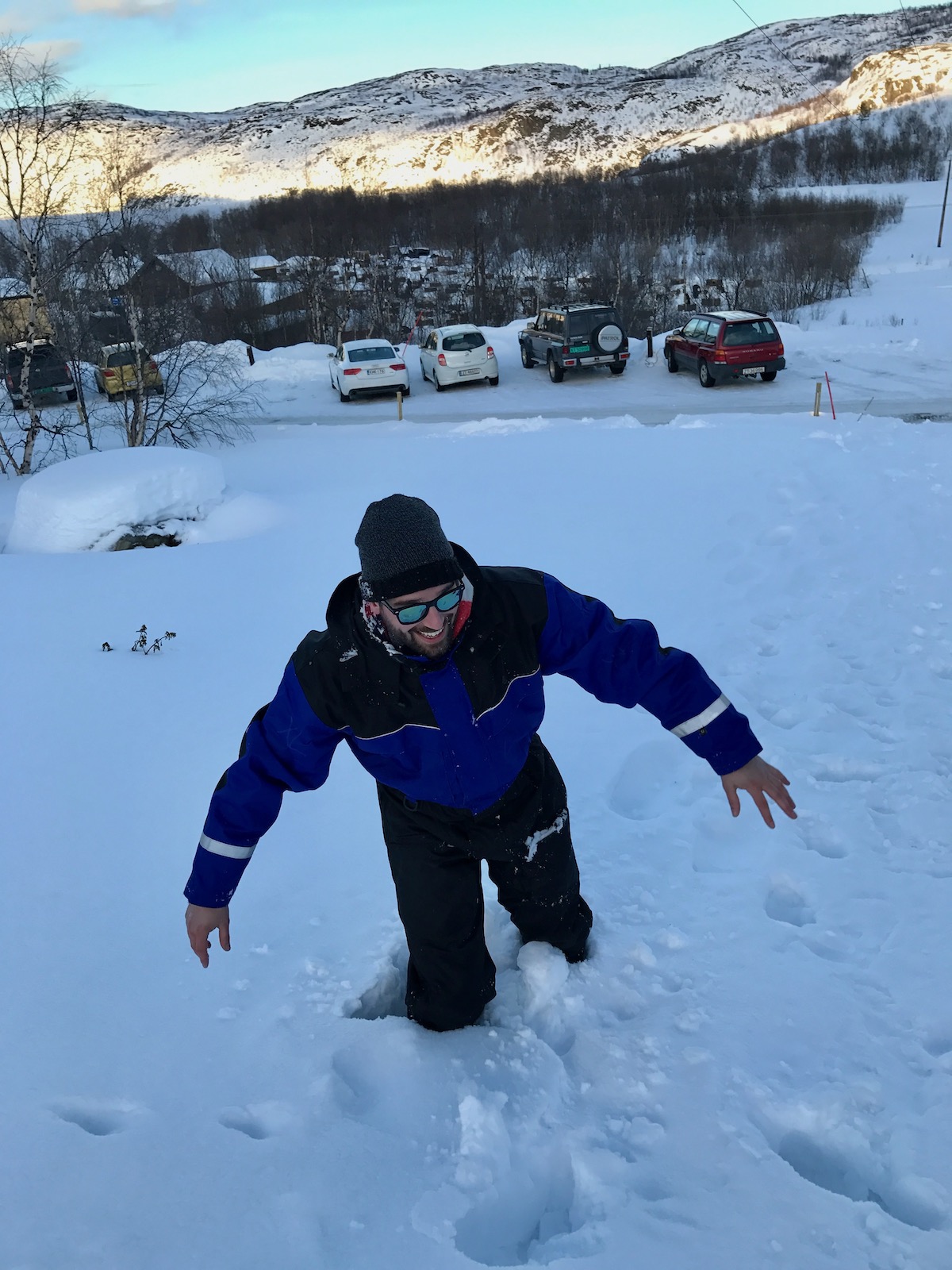
Aside from staying in an ice hotel in Norway and enjoying an array of heart-racing activities, the sheer beauty and great expanses of Kirkenes and its surrounding area offer up the perfect location for a spot for hiking.
The Kirkenes peninsula and the wider Sør-Varanger prefecture are swathed in breathtaking scenery, and an ever-changing one depending on the time of the year and the season.
During the slightly warmer Spring and Summer months, the land around the ice hotel in Norway thaws out and becomes surprisingly green. Hiking across the landscapes of heather, and green forests, and following the waters of the lakes and fjords makes the Sør-Varanger region the perfect hiking surroundings.
Even in the winter months, the blankets of snow and ice create their own winter beauty and as long as you are prepared with reliable routes and winter clothing, hiking here during the low-light months can be just as enjoyable.
Know before you go:
- Location – Hiking routes around Kirkenes can be found in every direction and in a variety of surroundings.
- Cost – Free (unless you go hardcore and have to use clumpy snowshoes).
- Opening hours – It’s best to hike when you have the most amount of light, giving you the best chance of finding your way around and not getting lost.
- Time needed – With so many different routes to choose from, you can hike closer to the Snow Hotel and as far out as the Norwegian – Russian border.
11. Attend Grenseløsfestivalen
During the first weekend in September every year since 2012, Kirkenes has hosted the Grenseløsfestivalen, a music festival within the Arctic Circle. Playing host to a variety of different artists, the lineup for the Grenseløsfestivalen changes every year, making it a popular event amongst music lovers.
While some may dream of the more fashionable world-famous festivals such as Glastonbury and Coachella, attending the less-known Grenseløsfestivalen is a truly unique cultural festival. Held within and close to the local athletics field of Barentshallene Sør-Varanger KF, the music festival is often combined with the local beer festival similar to Oktoberfest.
If you are planning to stay at the ice hotel in Norway during the first weekend of September, be sure to secure tickets for Grenseløsfestivalen as it is a fantastic social event, drawing in crowds from across northern Europe.
Know before you go:
- Location – The festival takes place just south of the town, close to the athletics field of Barentshallene Sør-Varanger KF.
- Cost – Around NOK 1,760 for a full-day ticket.
- Opening hours – 6 pm until late.
- Time needed – As there is so much to see, this will take up most of your evening.
- Getting there – Being within a small town, it is possible to walk to the festival site.
12. Soviet Liberation Monument
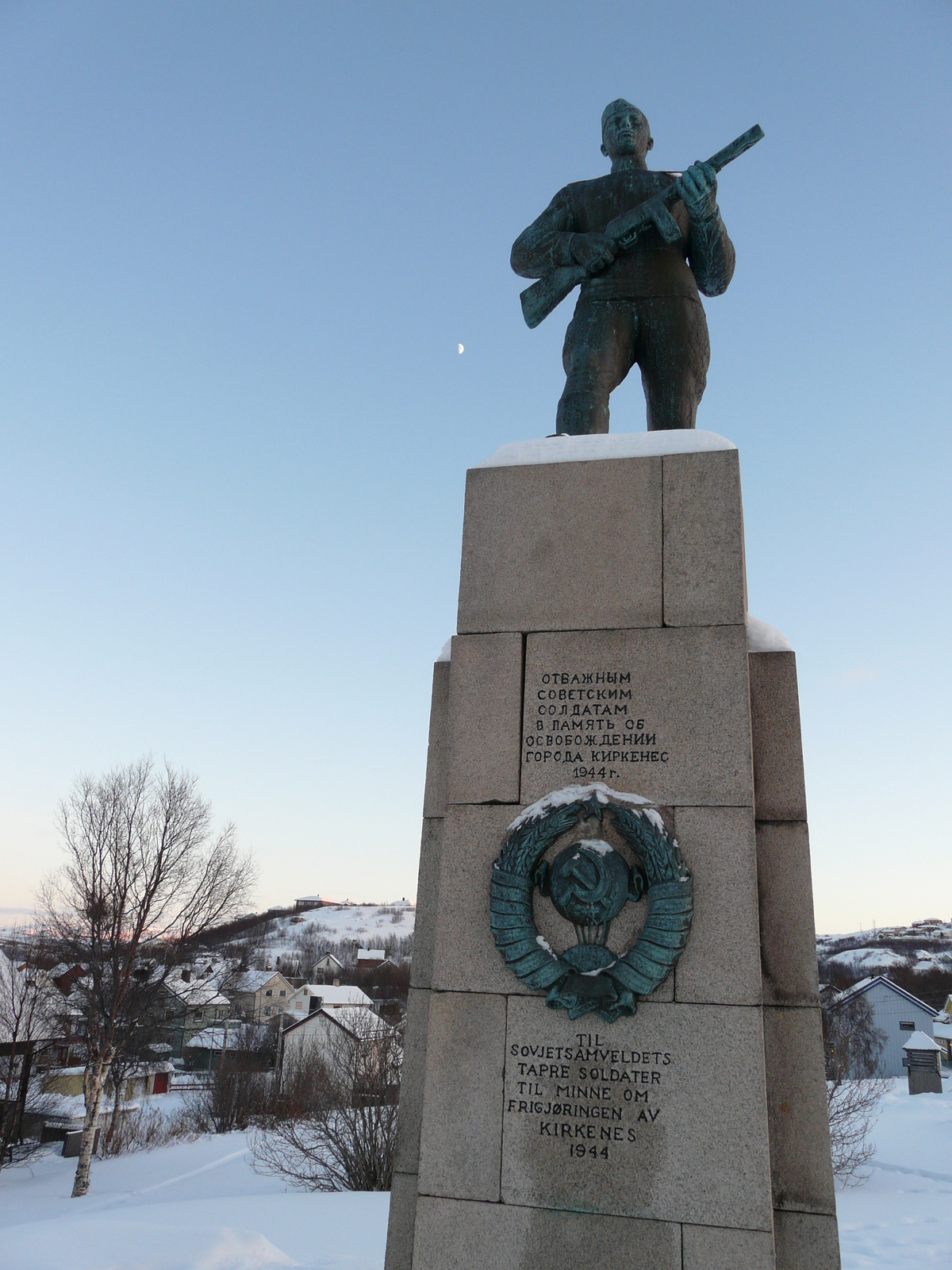
Once the Russian army steamroller began its invasion of Germany-occupied Eastern Europe during the final years of the Second World War, it pushed from Ukraine in the south right up to the Norwegian border in the north.
On October 23, 1944, Soviet Forces began the recapture of Kirkenes, with the retreating Nazi army operating a ‘scorched earth’ policy, destroying bridges, buildings and anything that could help the invading Soviet forces.
Although much of the town was destroyed in the fighting, the Soviet Army captured Kirkenes and the wider Finnmark region, resulting in just under 3,000 casualties for the Russians. Unlike much of captured Eastern Europe, Kirkenes and the wider Norwegian land was returned to Norway at the end of the war.
The modern locals of Kirkenes, many of which are ethnically Russian, never forget the sacrifices the USSR made by liberating the town and there now stands a monument commemorating that sacrifice, with the inscription “To the brave Soviet soldiers in memory of the liberation of the city of Kirkenes in 1944.”.
Taking the form of a Soviet soldier holding a PPSh-41 submachine gun and standing on the German eagle, the monument stands on a hill and former cave system the local Norwegians used to hide from the destruction caused by the fighting.
- Location – The Soviet Liberation Monument is located on the road known as Roald Amundsens Gate.
- Cost – Free.
- Opening hours – 24 hours.
- Time needed – A few minutes to see the monument and maybe take a snap.
- Getting there – Being in the centre of town and on a small hill, walking to the monument is easy and can be quite enjoyable.
13. Drink Local Booze in a (Gamme) Cabin
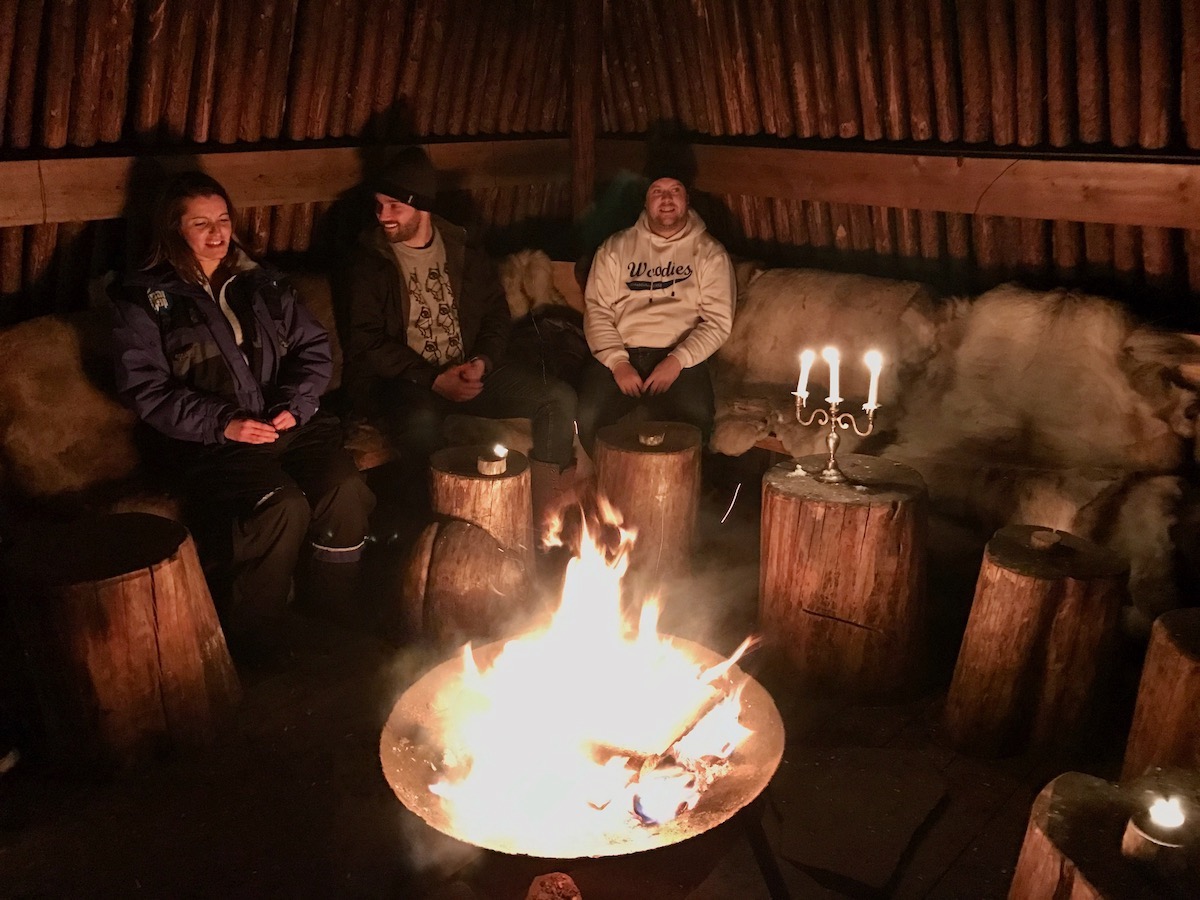
Aside from the ice and snow hotels, Kirkenes and the Snow Hotel are also home to Gamme; wooden circle cabins, that offer warm and comfortable shelter from the elements.
Once you have had your kick of sleeping surrounded by ice and snow, sitting in the comparative warmth of a Gamme cabin seems like domestic heaven. As well as using it as a place to kip, the cabins become the social hubs where you and your friends can relax and enjoy an evening drink and maybe get another bite of The Northern Lights cherry.
The cosy wooden structures provide the ideal atmosphere for a good old fashion drinking session. Local liquor stores are great places to pick up a drink or two and although you may be tempted to stick with a beer, no evening drinking here is complete without a few drops of aquavit. The traditional Scandinavian spirit is a blend of grain or potato-based alcohol similar to vodka yet flavoured with herbs and spices.
Teetotalers can have just as much fun with a cuppa tea/coffee/cocoa, of course, the main highlight here is the traditional cabin, not what beverage passes your shivering lips.
Know before you go:
- Location – The Gamme cabins are located directly on your hotel’s site.
- Cost – Renting a cabin for the night varies in price, but using your social skills to join others in theirs is always a great option. Nightly rates hover around the 6,000 NOK mark.
- Opening hours – Until the drink or call of your own frosty bed gets way too much!
14. Spot Wildlife in Pasvik Nature Reserve
Hidden amongst the valley of Pasvikdalen in Norway and Russia is the Pasvik Nature Reserve, a great expanse of protected wilderness and beauty. Spanning huge amounts of land and crossing two countries, visiting the Pasvik Nature Reserve is a dream come true for those who love exploring wild and relatively untouched parts of the world.
Aside from the sheer natural beauty of the place, as the name would suggest, Pasvik Nature Reserve is also home to an abundance of nature and wildlife. While exploring Pasvik Nature Reserve, you have the opportunity to catch sight of animals such as moose, reindeer, wild horses, brown bears, deer, and so much more. Start your trip at the National Park Information Centre at Bioforsk Svanvik, and venture out into the wilderness.
Although many hikes should only be attempted by those who are highly experienced at navigating these terrains, there are many travel agencies that organise trips to and around Pasvik Nature Reserve.
Know before you go:
- Location – The Pasvik Nature Reserve is located south of Kirkenes, close to the Russian border.
- Cost – Tour prices vary depending on how far you want to venture and how long you want to stay. Set aside at least 2,500 NOK.
- Opening hours – Tours usually take place during the day, when the light is at its best.
- Time needed – Give yourself at least three hours to explore the reserve and spot the wildlife.
- Getting there – Tours tend to provide their own transport, though it is possible to catch a taxi if you are planning to do it independently.
15. Andersgrotta Bomb Shelter
Andersgrotta bomb shelter sits in the centre of Kirkenes and is one of the last remnants of the conflict that ravaged the town during the Second World War.
As one of the most bombed areas of Europe during the war, Soviet bombs constantly dropped on the German-occupied town, and the locals needed shelter to protect themselves.
The Andersgrotta bomb shelter is an underground shelter of vast proportions burrowed out from the rock; its labyrinthine cave passages helped hide the town’s population during these many air raids.
Today, the Andersgrotta bomb shelter has been preserved for many generations to come. When visiting the shelter, you will be shown a short film about Kirkenes in war, based on archives and new recordings.
Aside from being one of the best historical spots in the town, it is one of the best Second World War sites in all of northern Europe.
Know before you go:
- Location – The bomb shelter is located in the town’s residential area, not far from the centre of town.
- Cost – 200 NOK entry fee
- Opening hours – 10 am – 3 pm.
- Time needed – Set aside between 40 minutes and an hour.
- Getting there – You can arrange a tour with your hotel, or head there yourself either via foot or rental car.
16. Amfi Kirkenes Mall
With such a strong Soviet hangover, you could be forgiven for assuming that such a strong statement of modern capitalism such as a shopping mall would be non-existent.
And yet, close to the port of Kirkenes lies the Amfi Kirkenes Mall, one of the main shopping locations in the town. Although not a giant shopping mall as you would find in major cities around the world, Amfi Kirkenes Mall has a number of shops, offering up everything from food goods, camp equipment and arguably the most famous, the alcohol store.
Though it may be seen as one of the most expensive wine and spirit stores in Norway, Amfi Kirkenes Mall’s booze shop sells a huge range of wines, beers, spirits and other drinks, perfect for a memento of your trip to Kirkenes.
Whether you need to stock up on supplies or simply spend a few hours perusing, Amfi Kirkenes Mall is a great thing to check out when in the town of Kirkenes.
Know before you go:
- Location – Located at the very north of the town, along Stargate Road.
- Cost – Goods at the mall will have a variety of prices, depending on the store and the items themselves.
- Opening hours – 9 am – 7 pm.
- Time needed – A couple of hours should be enough to browse the many shops here.
- Getting there – The AMFI Kirkenes bus stop is located directly outside the Snow Hotel.
17. Cross-Country Skiing
When it comes to fun winter activities for travellers, Kirkenes is up there with the best of them, even with its isolation and lack of prestige.
As well as husky sledding and snowmobile tours, you can also put your fitness to the test with a day of cross-country skiing. Organised by the Snow Hotel, you can strap up your cross-country skis and take to the snow-white landscapes surrounding the town and the wider area.
During the winter months, hiking through the snow-strewn landscape is nearly impossible due to the levels of ice and snow. Strapping on skis makes this once-impossible task achievable, just take your time and bend your legs if you’re a newbie like me!
Know before you go:
- Location – You will begin from the Snow Hotel and cross-country skiing throughout the surrounding area.
- Cost – The skis are available to guests as part of their stay.
- Opening hours – Most skiing takes place during daylight hours and the winter season.
- Time needed – Take as long as you wish to explore the area.
- Getting there – Your hotel or tour operator will organise any transport that you may need.
18. Fat Biking
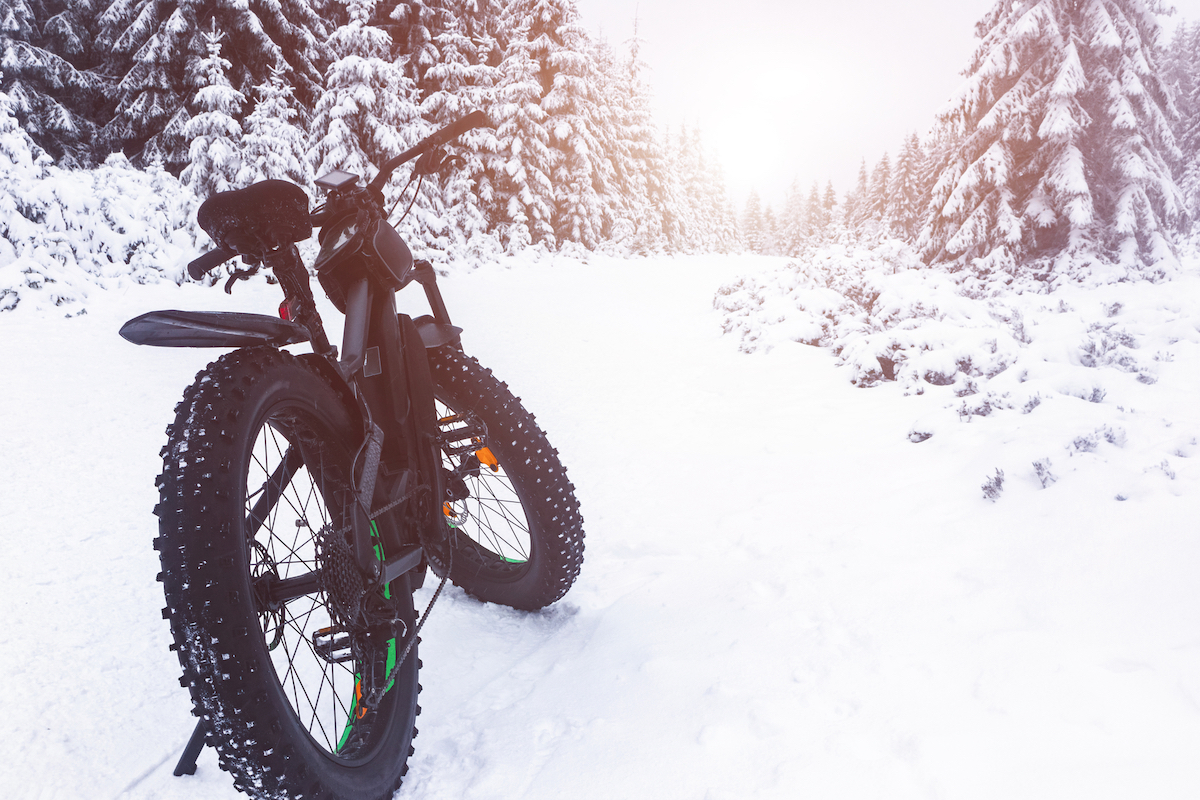
Aside from snowshoes and cross-country skis, there is an often overlooked or unknown way of traversing the winter landscapes of Kirkenes, and that is with a fat bike.
A fat bike is similar to a mountain bike but is oversized in many ways. The ‘fat’ name comes from the oversized and fat tires that make up the bike, allowing you to ride it across unstable surfaces such as snow without getting snowed under.
Taking your bike, you can traverse the many trails and routes that surround Kirkenes, giving you much more freedom to go further afield and my God, it’s a solid workout for your legs.
Know before you go:
- Location – The bike can be rented from the hotel or from in the town.
- Cost – Costs will vary depending on where you rent them from. I lost my notes for this, that’s the truth. I’m sorry!
- Opening hours – It’s best to bike during the daylight hours, allowing you to stay safe in the wilderness.
- Time needed – N/A
- Getting there – A good few hours of biking will be enough, though if your fitness levels are higher, you can spend far longer.
19. Day Trip 1: From Kirkenes To Vardo Fortress
Across the Barents Sea, a little away from Kirkenes, is the small fishing town of Vardø. This unassuming town was, in fact, extremely valuable for the Arctic Circle and Europe for centuries. So much so, that they decided to build a fortification alongside it.
Long being a place of conflict, the first Vardø Fortress was built by King Haakon V of Norway during the early 14th century, and buildings were added over the next few hundred years, with the modern fortress we see today erected during the early 18th century.
Falling into disrepair, the fortress became another focal point during the early to mid-20th century with the outbreak of the two world wars.
First occupied by the Norwegian army at the outbreak of the Second World War, Vardø Fortress was modernised and reinforced with modern bunkers and a garrison of Norwegian soldiers. With the German invasion of Norway in 1940, the fortress came under Nazi occupation and was again reinforced.
During the post-war years, Vardø Fortress became a prison and held those who had been convicted of treason for collaborating with Nazi Germany before being turned into a museum during the later part of the century.
Aside from the interesting town and fortress, the day trip to Vardøhus Fortress is an adventure within itself. Using public transport (or private if you pay the premium) you can make your way to Vardø and its fortress, including a ride on the famous coastal steamer Hurtigruten and back to Kirkenes.
The boat leaves Kirkenes each day at around 12:30 and arrives at Vardø at 15:45. Vardø is the first stop of the southbound journey of Hurtigruten voyage from Kirkenes to Bergen.
You can buy the boat ticket onboard or order it online to secure your spot before you travel.
Know before you go:
- Location – Vardøhus Fortress is located north of Kirkenes, across the Barents Sea.
- Cost – The fortress is free to visit, but the boat journey will set you back between NOK 300 and NOK 500 per person.
- Opening hours – 24 hours.
- Time needed – Take the whole day to travel there and back, including visiting the fortress.
20. Day Trip 2: Check Out Russia (AND Finland) Border
Sitting so close to the national borders of Finland and Russia, a day spent exploring this region teaches you about the longstanding border wars that took place throughout history as well as introduces you to some of the most beautiful and remote wildernesses around Kirkenes and the Arctic Circle.
2024 edit: The current war between Russia and Ukraine does not affect this crossing of the border in Finmark.
Day tours to this part of the world usually include exploration of the region around the borders, a chance to admire the unbelievable landscapes and unique wildlife and above all else, the breathtaking fjords, you’ll undoubtedly want to stop along the way to get some fancy snaps.
While the borders of Norway and Russia run for over 100 miles, there is only one crossing in the region, and that is at the towns of Storskog in Norway and Borisoglebsky in Russia.
Organisers will not make the crossing as part of the tour, though it is possible to make it alone if you have the right planning and documentation.
Know before you go:
- Location – The border is a half an hour’s drive south of Kirkenes.
- Cost – A tour of the region will set you back around NOK 630 per person.
- Opening hours – N/A
- Time needed – The tour will take most of the day, considering the distance of travel and sightseeing.
- Getting there – As part of a tour, you will have transport organised for you.
There are plenty more things to do in Kirkenes than stay in the Ice Hotel (as cool as that might be). Norway is a truly underrated destination when you factor in the Arctic Circle as part of the package.


